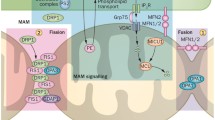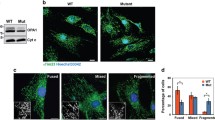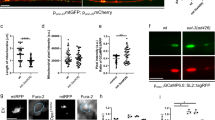Abstract
The optic atrophy 3 (OPA3) gene, which has no known homolog or biological function, is mutated in patients with hereditary optic neuropathies. Here, we identified OPA3 as an integral protein of the mitochondrial outer membrane (MOM), with a C-terminus exposed to the cytosol and an N-terminal mitochondrial targeting domain. By quantitative analysis, we demonstrated that overexpression of OPA3 significantly induced mitochondrial fragmentation, whereas OPA3 knockdown resulted in highly elongated mitochondria. Cells with mitochondria fragmented by OPA3 did not undergo spontaneous apoptotic cell death, but were significantly sensitized to staurosporine- and TRAIL-induced apoptosis. In contrast, overexpression of a familial OPA3 mutant (G93S) induced mitochondrial fragmentation and spontaneous apoptosis, suggesting that OPA3 mutations may cause optic atrophy via a gain-of-function mechanism. Together, these results indicate that OPA3, as an integral MOM protein, has a crucial role in mitochondrial fission, and provides a direct link between mitochondrial morphology and optic atrophy.







Similar content being viewed by others
References
Nunnari J, Marshall WF, Straight A, Murray A, Sedat JW, Walter P (1997) Mitochondrial transmission during mating in Saccharomyces cerevisiae is determined by mitochondrial fusion and fission and the intramitochondrial segregation of mitochondrial DNA. Mol Biol Cell 8:1233–1242
Yaffe MP (1999) The machinery of mitochondrial inheritance and behavior. Science 283:1493–1497
Shaw JM, Nunnari J (2002) Mitochondrial dynamics and division in budding yeast. Trends Cell Biol 12:178–184
Honda S, Hirose S (2003) Stage-specific enhanced expression of mitochondrial fusion and fission factors during spermatogenesis in rat testis. Biochem Biophys Res Commun 311:424–432
Youle RJ, Karbowski M (2005) Mitochondrial fission in apoptosis. Nat Rev Mol Cell Biol 6:657–663
Zuchner S, Mersiyanova IV, Muglia M, Bissar-Tadmouri N, Rochelle J, Dadali EL, Zappia M, Nelis E, Patitucci A, Senderek J, Parman Y, Evgrafov O, Jonghe PD, Takahashi Y, Tsuji S, Pericak-Vance MA, Quattrone A, Battaloglu E, Polyakov AV, Timmerman V, Schroder JM, Vance JM (2004) Mutations in the mitochondrial GTPase mitofusin 2 cause Charcot-Marie-Tooth neuropathy type 2A. Nat Genet 36:449–451
Deng H, Dodson MW, Huang H, Guo M (2008) The Parkinson’s disease genes pink1 and parkin promote mitochondrial fission and/or inhibit fusion in Drosophila. Proc Natl Acad Sci USA 105:14503–14508
Delettre C, Lenaers G, Griffoin JM, Gigarel N, Lorenzo C, Belenguer P, Pelloquin L, Grosgeorge J, Turc-Carel C, Perret E, Astarie-Dequeker C, Lasquellec L, Arnaud B, Ducommun B, Kaplan J, Hamel CP (2000) Nuclear gene OPA1, encoding a mitochondrial dynamin-related protein, is mutated in dominant optic atrophy. Nat Genet 26:207–210
Anikster Y, Kleta R, Shaag A, Gahl WA, Elpeleg O (2001) Type III 3-methylglutaconic aciduria (optic atrophy plus syndrome, or Costeff optic atrophy syndrome): identification of the OPA3 gene and its founder mutation in Iraqi Jews. Am J Hum Genet 69:1218–1224
Reynier P, Amati-Bonneau P, Verny C, Olichon A, Simard G, Guichet A, Bonnemains C, Malecaze F, Malinge MC, Pelletier JB, Calvas P, Dollfus H, Belenguer P, Malthiery Y, Lenaers G, Bonneau D (2004) OPA3 gene mutations responsible for autosomal dominant optic atrophy and cataract. J Med Genet 41:e110
Da Cruz S, Xenarios I, Langridge J, Vilbois F, Parone PA, Martinou JC (2003) Proteomic analysis of the mouse liver mitochondrial inner membrane. J Biol Chem 278:41566–41571
Davies VJ, Powell KA, White KE, Yip W, Hogan V, Hollins AJ, Davies JR, Piechota M, Brownstein DG, Moat SJ, Nichols PP, Wride MA, Boulton ME, Votruba M (2008) A missense mutation in the murine Opa3 gene models human Costeff syndrome. Brain 131:368–380
Karbowski M, Norris KL, Cleland MM, Jeong SY, Youle RJ (2006) Role of Bax and Bak in mitochondrial morphogenesis. Nature 443:658–662
Lee YJ, Jeong SY, Karbowski M, Smith CL, Youle RJ (2004) Roles of the mammalian mitochondrial fission and fusion mediators Fis1, Drp1, and Opa1 in apoptosis. Mol Biol Cell 15:5001–5011
Parcellier A, Tintignac LA, Zhuravleva E, Dummler B, Brazil DP, Hynx D, Cron P, Schenk S, Olivieri V, Hemmings BA (2009) The carboxy-terminal modulator protein (CTMP) regulates mitochondrial dynamics. PLoS One 4:e5471
Votruba M, Aijaz S, Moore AT (2003) A review of primary hereditary optic neuropathies. J Inherit Metab Dis 26:209–227
Chung KW, Kim SB, Park KD, Choi KG, Lee JH, Eun HW, Suh JS, Hwang JH, Kim WK, Seo BC, Kim SH, Son IH, Kim SM, Sunwoo IN, Choi BO (2006) Early onset severe and late-onset mild Charcot-Marie-Tooth disease with mitofusin 2 (MFN2) mutations. Brain 129:2103–2118
James DI, Parone PA, Mattenberger Y, Martinou JC (2003) hFis1, a novel component of the mammalian mitochondrial fission machinery. J Biol Chem 278:36373–36379
Yoon Y, Krueger EW, Oswald BJ, McNiven MA (2003) The mitochondrial protein hFis1 regulates mitochondrial fission in mammalian cells through an interaction with the dynamin-like protein DLP1. Mol Cell Biol 23:5409–5420
Chen H, Detmer SA, Ewald AJ, Griffin EE, Fraser SE, Chan DC (2003) Mitofusins Mfn1 and Mfn2 coordinately regulate mitochondrial fusion and are essential for embryonic development. J Cell Biol 160:189–200
Frederick RL, McCaffery JM, Cunningham KW, Okamoto K, Shaw JM (2004) Yeast Miro GTPase, Gem1p, regulates mitochondrial morphology via a novel pathway. J Cell Biol 167:87–98
Karbowski M, Lee YJ, Gaume B, Jeong SY, Frank S, Nechushtan A, Santel A, Fuller M, Smith CL, Youle RJ (2002) Spatial and temporal association of Bax with mitochondrial fission sites, Drp1, and Mfn2 during apoptosis. J Cell Biol 159:931–938
Sugioka R, Shimizu S, Tsujimoto Y (2004) Fzo1, a protein involved in mitochondrial fusion, inhibits apoptosis. J Biol Chem 279:52726–52734
Acknowledgments
This research was supported by Basic Science Research Program through the National Research Foundation of Korea (NRF) funded by the Ministry of Education, Science and Technology (KRF-2008-359-C00026). This research was also supported in part by a grant (2009K001282) from the Brain Research Center of the twenty-first Century Frontier Research Program funded by the Ministry of Education, Science, and Technology, Republic of Korea (to C. C.). We acknowledge Dr. Richard J. Youle’s valuable comments on the manuscript and support in some aspects of the work. We also thank Soojay Banerjee for technical support.
Author information
Authors and Affiliations
Corresponding authors
Electronic supplementary material
Below is the link to the electronic supplementary material.
Supplementary Fig. 1
. The mitochondrial localization of OPA3. (A) The 20-kDa endogenous OPA3 was identified using anti-OPA3 antibody. HeLa cells were transfected with the indicated constructs, harvested, and analyzed by Western blotting using anti-OPA3 antibody (diluted 1:500). (B) Mitochondrial fraction with FLAG-OPA3 in control buffer or swelling buffer (OS) were digested by proteinase K (PK). Western blots of the separated proteins were probed with anti-FLAG, anti-Tom 20, and anti-OPA1 antibodies. (C) Mitochondrial fraction with OPA3-myc in control buffer or swelling buffer (OS) was digested by trypsin. Alkali (Na2CO3)-treated mitochondria were extracted, after ultracentrifugation to separate soluble and pelleted proteins. Western blots of the separated proteins were probed with anti-myc antibody (TIFF 20491 kb)
Supplementary Fig. 2. Effect of the patient OPA3 mutant (G93S) on mitochondrial morphology
(A) HeLa cells were transfected with OPA3-YFP or OPA3(G93S)-YFP. After 15 h, the cells were fixed and stained with fluorescently labeled Tom 20 antibody, and analyzed by confocal microscopy. Bar, 10 μm. (B) HeLa cells were transfected with the indicated constructs. Cells were treated with TRAIL for 6 h, stained with fluorescently labeled anti-cytochrome c antibody and analyzed by confocal microscopy. The number of cells displaying cytosolic cytochrome c was counted, and are shown as a percentage of the total cells counted in cell population (TIFF 19932 kb)
Rights and permissions
About this article
Cite this article
Ryu, SW., Jeong, H.J., Choi, M. et al. Optic atrophy 3 as a protein of the mitochondrial outer membrane induces mitochondrial fragmentation. Cell. Mol. Life Sci. 67, 2839–2850 (2010). https://doi.org/10.1007/s00018-010-0365-z
Received:
Revised:
Accepted:
Published:
Issue Date:
DOI: https://doi.org/10.1007/s00018-010-0365-z




